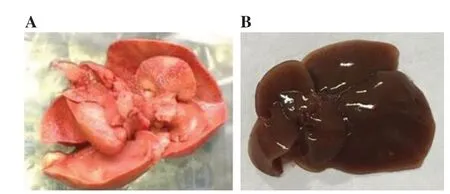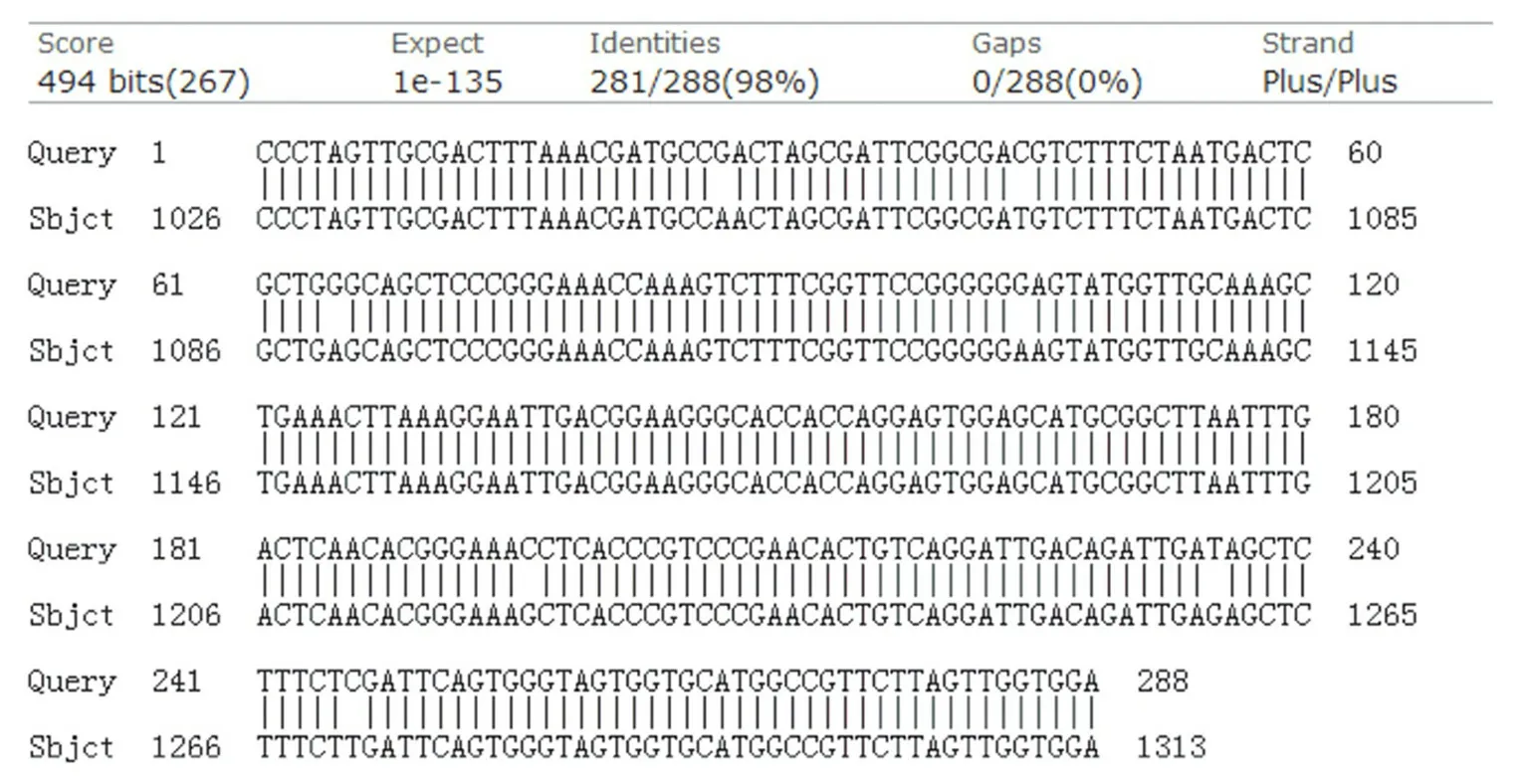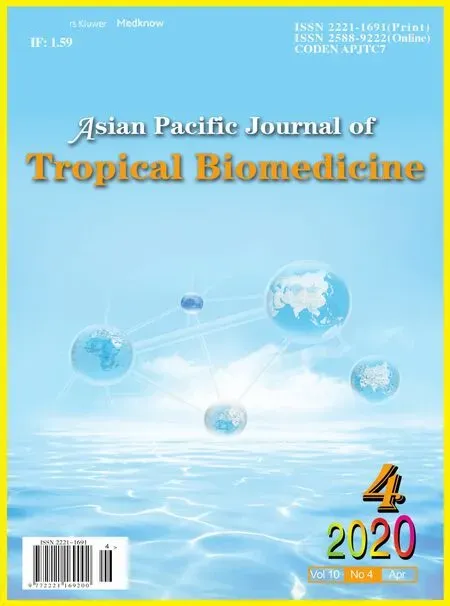Identification and investigation of Calodium hepaticum in rodents and insectivores from Wuhan section of the Yangtze River in China
Shui-Mao Zhou, Xian-Ling Jin, Hao Wang, Hua-Tang Luo, Xi-Shuai Jia✉
1Wuhan Centers for Disease Prevention and Control, Wuhan 430015, China
2Wuhan Xinzhou Schistosomiasis Control Institute, Wuhan 430015, China
ABSTRACT Objective: To investigate the prevalence of Calodium hepaticum (C. hepaticum) in rodents and insectivores from Wuhan section of the Yangtze River in China, and to provide evidence for the prevention and treatment of hepatic Calodium infection. Methods: Rodents and insectivores were captured from three selected Yangtze River beaches using mousetraps. The three survey sites were divided into six areas according to natural conditions, with 60 mousetraps placed in each area. The liver lesions in the captured rodents were observed by the naked eye and the eggs in the liver tissue were observed by microscopic examination.Results: A total of 1 080 mousetraps were placed, and 1 075 mousetraps were retrieved, with the retrieve rate as 99.5%. A total of 101 Apodemus agrarius, 12 Rattus norvegicus, and 9 Crocidura attenuata were caught. The average density of rodents and insectivores was 10.5% and 0.8%, respectively. DNA of egg nodules from infected rodents showed 98% similarity with that of C. hepaticum 18S rRNA (LC425008.1). One Rattus norvegicus was infected with C. hepaticum, with an infection rate of 3.23% in the Erqi river beach; the other two beaches did not show the incidence of C. hepaticum. Conclusions: The monitoring of C. hepaticum in the Yangtze River beaches should be strengthened to reduce the risk of human C. hepaticum infection.
KEYWORDS: Calodium hepaticum; Rodents; Insectivores; Yangtze River beach; PCR
1. Introduction
Calodium hepaticum (C. hepaticum) is a zoonotic nematode that is parasitic mainly on the liver of rodents. However, infections can spread to humans or other animals upon the ingestion of food or water contaminated with infective eggs, leading to hepatic Calodium infection[1]. The disease is easily transmitted and is a serious health concern. In China, the infection rate was as high as 7.14%-76.83%[1,2]. In the current study, we investigated the infection status of C. hepaticum among rodents and insectivores in the Wuhan section of the Yangtze River in China and provide a basis for effective control.
2. Materials and methods
2.1. Basic overview of the survey point
Three Yangtze River beach areas were selected; the survey site was Wuhan wetland reserve, with a wide area of river beach and lush plants. The Jincheng and Laozihu river beaches were far from the residential area, and the distance was more than 1 km. The Erqi river beach was close to the residential area, and a small number of residents lived on the beach (Figure 1).
2.2. Survey method

Figure 1. Distribution of the survey sites on the Yangtze River.
The night trapping method was used to capture rodents and insectivores. The distance between mousetraps was about 10 m×10 m; a medium-sized mousetrap was used and peanuts were used as baits. The rat clips were placed according to the natural environment and rat habits and were placed at night and collected in the morning. Each survey site was divided into six sections according to the natural conditions. In each survey area, 60 mousetraps were placed in the wild. The captured mammals were numbered and placed in white plastic bags, which were kept on ice packs and brought back to the laboratory for identification. The liver lesions were observed by the naked eye, and diseased liver tissues (nodule) were cut into slices. The infections in the liver tissue were observed by microscopic examination.
2.3. DNA extraction
Approximately 150 mg of diseased liver tissue was taken in a 2 mL centrifuge tube, ground for 2 min using RETSCH MM400 (Germany). Then, 1 mL double distilled water (ddH2O) was added, and samples were filtered using a 100-mesh screen. The filtrate was incubated for 10 min and then the supernatant was removed. This process was repeated five times. Then, 1 mL ddH2O was added and the samples were centrifuged at 1 000 g for 5 min; this step was repeated twice. This was followed by the removal of supernatant and extraction of DNA using the OMEGA Tissue DNA Kit (OMEGA, USA). The extracted DNA was stored at -20 ℃.
2.4. Molecular identification
Primer synthesis and sequencing were done by Sangon Biotech Co. Ltd. (Shanghai, China). The primer sequences of C. hepaticum[3] were as follows: F 5’-CCCTAGTTGCGACTTTAAACGA-3’ and R 3’-TCCACCAACTAAGAACGGCC-5’. The PCR conditions were as follows: 94 ℃ for 3 min, followed by 40 cycles at 94 ℃ for 60 s, 50 ℃ for 60 s, 72 ℃ for 60 s, followed by extension step at 72 ℃for 7 min. The sequencing results were analyzed using DNAstar 7.0 and NCBI Blast.
2.5. Ethical statement
The study was approved by WHCDC Ethical Committee (WHCDCIRB-K-2016015) on 16 December, 2016 and followed the 3R' s guideline.
3. Results
3.1. Distribution of rodents and insectivores
A total of 1 080 mousetraps were placed at the three survey sites on the Yangtze River beach and 1 075 mousetraps were retrieved (retrieve rate was 99.5%). As a result, 122 small mammals were caught, and these included 101 Apodemus agrarius (A. agrarius), 12 Rattus norvegicus (R. norvegicus), and 9 Crocidura attenuata (C. attenuata). Thus, we captured three species belonging to three genera, two families, and two orders (Table 1). The average density of rodents and insectivores was 10.5% and 0.8%, respectively.
3.2. Parasitic infections
Of the captured mammals, 77 A. agrarius, 9 R. norvegicus, 5 C. attenuata were captured in Jincheng and Laozihu; C. hepaticum was not found in these two sites. From Erqi, we captured 24 A. agrarius, 3 R. norvegicus, and 4 C. attenuata; the infection rate of C. hepaticum in these captured mammals was 3.23% (1/31) (Table 1).

Table 1. Distribution of rodents and insectivores in the Yangtze River beaches (n).

Figure 2. Liver of Rattus norvegicus infected with Calodium hepaticum (A) and normal liver of Rattus norvegicus (B).
3.3. Shape of the liver and egg of R. norvegicus infected with C. hepaticum
The liver of R. norvegicus infected with C. hepaticum was hard, and the liver was swollen with yellowish or white spots and filamentous or flaky lesions, which were prominent on the liver surface (Figure 2A). Microscopic examination showed that these eggs were colorless and shaped like a waist drum, and their average size was about 51 to 67 μm in length and 30 to 35 μm in width. The eggshell was thick and showed radial stripes. Transparent plugs were observed at both ends of the egg, which were not prominent outside the shell; a celllike structure could be seen inside (Figure 3A-C).
3.4. Molecular identification
Using PCR and C. hepaticum-specific primers, 288 bp target fragment was amplified for the molecular identification of C. hepaticum (Supplementary Figure 1). The target fragment, analyzed using DNAstar 7.0 and NCBI Blast, showed 98% similarity with the C. hepaticum 18S rRNA sequence (LC425008.1) (Figure 4).
4. Discussion
Hepatic Calodium infection is a parasitic zoonosis. More than 60 species of mammals are hosts of C. hepaticum, which causes severe liver disease, leading to liver damage, liver function disorders, liver fibrosis, eosinophilia, and even death[1].
In this study, we investigated the prevalence of C. hepaticum at three Yangtze River beaches, from where 101 A. agrarius, 12 R. norvegicus, and 9 C. attenuata were caught; the average density was 11.3%. DNA extracted from the liver of these animals was subjected to PCR and the amplified target fragment sequence was analyzed using NCBI blast. As a result, we found 98% similarity with the C. hepaticum 18S rRNA sequence (LC425008.1), indicating that the infectious parasite could be C. hepaticum. Based on the shape of eggs and parasitic position in the infected animals, the infecting species was then confirmed to be C. hepaticum.
R. norvegicus seemed to be the main host species of C. hepaticum[4], as it was the only rodent infected in this study. This is consistent with other studies that reported a high infection rate in R. norvegicus, compared with that in other rodents.
The infection rate varies among the R. norvegicus living at different locations; the prevalence of C. hepaticum was higher in house R. norvegicus than in field R. norvegicus[1]. In this study, the R. norvegicus was caught from wild river beaches. The infection rate of C. hepaticum was 3.23%, which was lower than that reported in Henan Province[5] (13.5%), Dali City[2] (24.3%), and Wenzhou City[6] (18.3%), although the rodents in these cities were caught from indoor areas (such as slaughterhouses and factories).
Rodent is a major risk factor for the transmission of C. hepaticum to humans. In this study, we found no infected rodents in the two river beaches that were farther than 1 km away from where people lived; however, the R. norvegicus captured from the beach that was in close proximity to where humans were settled was infected with C. hepaticum. This is of concern, as it poses the risk of contamination of soil, environment and food, and a greater possibility of the infection transmission to humans.

Figure 3. Result of microscopic examination. A: The egg nodule of Calodium hepaticum-infected liver (100×); B: The eggs in Calodium hepaticum-infected liver tissue (200×); C: The scattered eggs in Calodium hepaticum-infected liver tissue (400×).

Figure 4. Sequence alignment results: partial sequence of Calodium hepaticum NSMT.
Previously, 163 cases of humans infected with C. hepaticum were analyzed by Fuehrer[7], including 72 cases confirmed by liver biopsy, 13 cases confirmed by serology, 78 cases of spurious infection, and 72 cases of genuine infection with a high mortality rate of 61%. Since the eggs produced by adult worms are mainly deposited in the liver without being excreted, it is difficult to make a clinical diagnosis after human infection, and the final diagnosis must rely on a biopsy or autopsy. Moreover, the rate of misdiagnosis and missed diagnosis is high[8], with only a few human cases actually reported[9]. Hepatic Calodium infection should be considered when eosinophilia is found to increase clinically, the liver is enlarged and the patient complains of pain, and other parasitic infections are ruled out[10].
To summarize, we report the prevalence of C. hepaticum on the Yangtze River beaches. Our study indicates that the Yangtze River beach area could be an epidemic disease reservoir for hepatic Calodium infection. The beaches are wetland reserves, which are difficult to manage. Therefore, effective measures should be taken to exterminate the rodents, rodent carcasses, and their excrement should be disposed properly to avoid the environment pollution by infected eggs. Health education on the prevention and treatment of C. hepaticum infection should also be carried out to encourage residents to change their poor health and living habits so as to reduce the chances of infection.
Conflict of interest statement
We declare that there is no conflict of interest.
Funding
This study is financially supported by the Health Bureau of Wuhan (WG17B04), the Health Bureau of Wuhan(WG18Q05).
Authors’ contributions
ZSM and JXS conceived the study. ZSM, JXL and JXS undertook statistical analysis, and drafted the manuscript. WH and LHT undertook epidemiological investigations and sample collection. All authors contributed to the writing of the manuscript and approved the submitted version of the manuscript.
 Asian Pacific Journal of Tropical Biomedicine2020年4期
Asian Pacific Journal of Tropical Biomedicine2020年4期
- Asian Pacific Journal of Tropical Biomedicine的其它文章
- Information for Authors Asian Pacific Journal of Tropical Biomedcine
- Antibacterial activity of bacillomycin D-like compounds isolated from Bacillus amyloliquefaciens HAB-2 against Burkholderia pseudomallei
- Anti-Acinetobacter baumannii activity of Rumex crispus L. and Rumex sanguineus L. extracts
- Free and liposome form of gallic acid improves calvarial bone wound healing in Wistar rats
- A novel polyherbal formulation containing thymoquinone attenuates carbon tetrachloride-induced hepatorenal injury in a rat model
